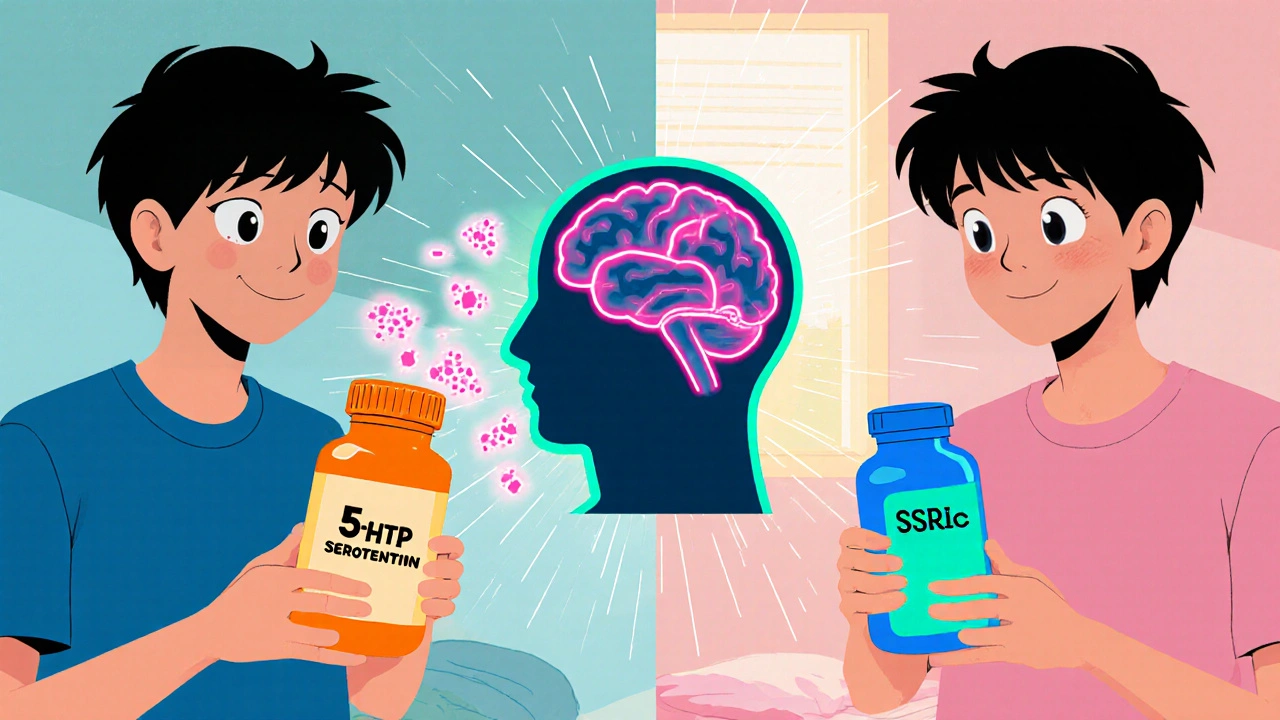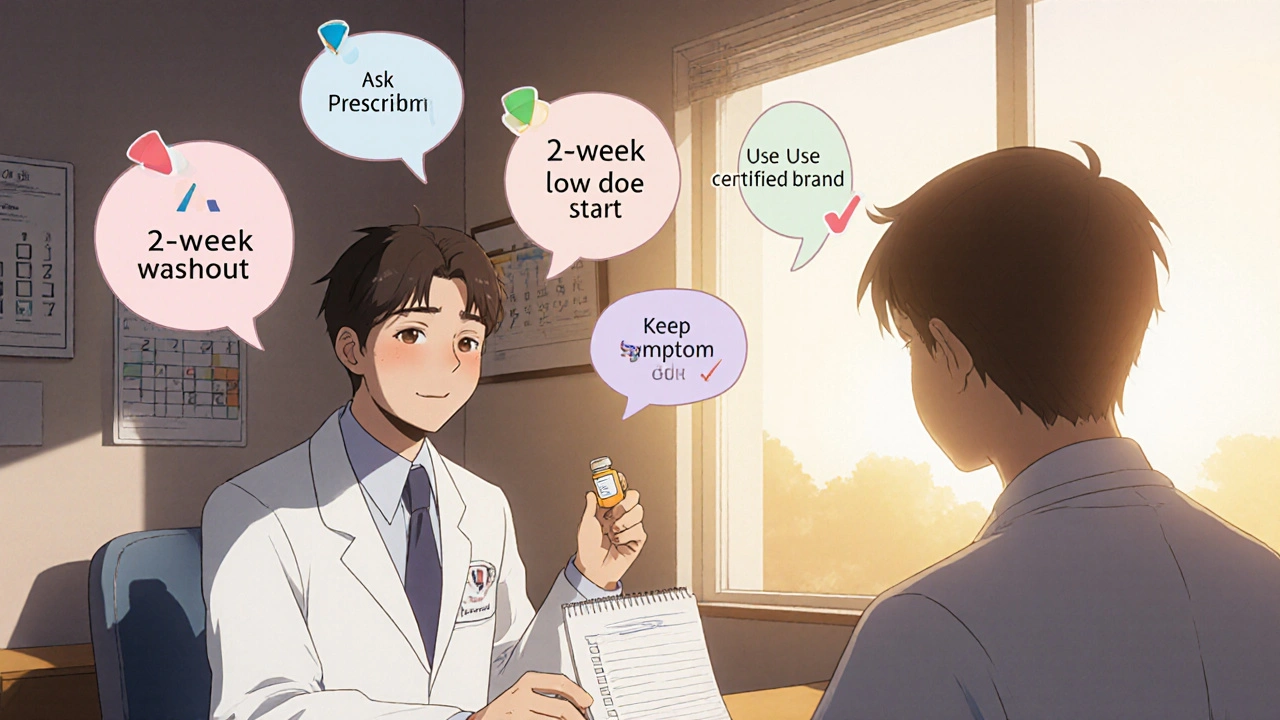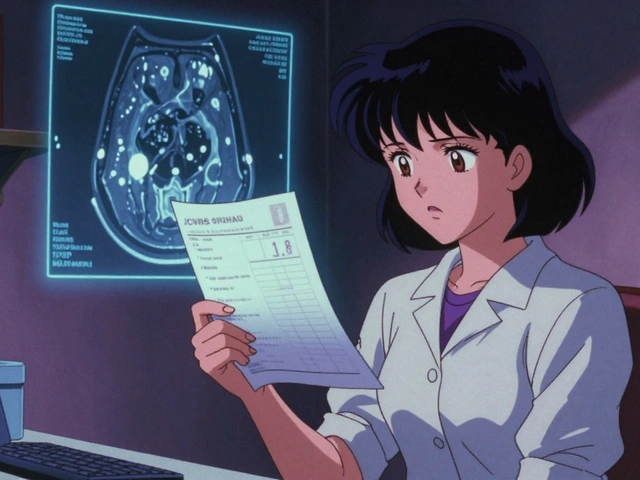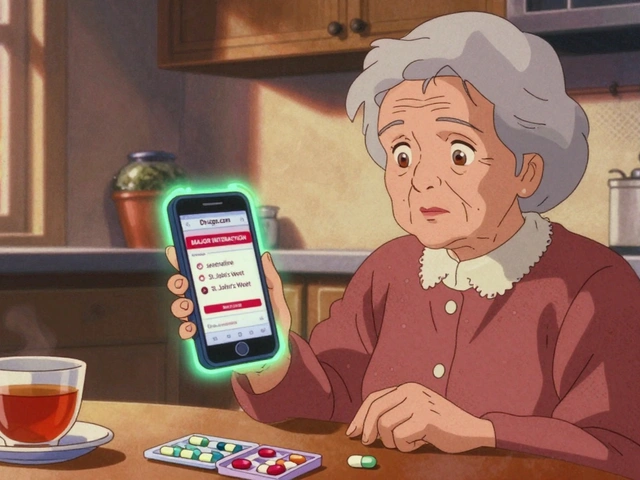
Serotonin Syndrome Risk Calculator
This tool estimates your risk of serotonin syndrome when combining 5-HTP with an SSRI antidepressant based on scientific evidence from the article.
Mixing a serotonin‑boosting supplement with an antidepressant can feel like a good idea, but it may also set off a dangerous chain reaction called serotonin syndrome. Below you’ll learn what 5‑HTP and SSRIs do, why their combo is risky, how to spot the warning signs, and what steps keep you safe.
What is 5‑HTP and how does it work?
5‑HTP is a naturally occurring amino acid that the body turns into serotonin, the brain chemical that regulates mood, sleep, and appetite. Unlike the amino acid tryptophan, 5‑HTP bypasses the rate‑limiting enzyme tryptophan hydroxylase, so it can flood the brain with serotonin when taken in doses of 50-300 mg per day. Over‑the‑counter brands often claim mood‑lifting or weight‑loss benefits, but the dose on the label is not always reliable - a 2022 ConsumerLab.com analysis found 31 % of products deviated by more than 20 % from what they said.
What are SSRIs and how do they affect serotonin?
SSRIs (selective serotonin reuptake inhibitors) are prescription antidepressants that block the reabsorption of serotonin at synapses, keeping more of the neurotransmitter available for signaling. Common SSRIs include fluoxetine (Prozac), sertraline (Zoloft), and citalopram (Celexa). Their typical therapeutic dose raises serotonin by about 30‑40 % without dramatically increasing overall production. Because they work by preventing serotonin clearance, SSRIs on their own rarely cause serotonin syndrome - the incidence is under 0.5 cases per 1,000 person‑years.
Serotonin syndrome: the ‘perfect storm’
Serotonin syndrome occurs when too much serotonin overloads the central nervous system, especially the 5‑HT2A receptors. Normal blood serotonin sits between 101‑283 ng/mL; levels above 300‑400 ng/mL can trigger toxic effects. The condition can range from mild (shivering, diarrhoea, tremor) to life‑threatening (hyperthermia >41 °C, rigid muscles, seizures, organ failure). Mortality in severe cases is estimated at 2‑12 %.
Why the 5‑HTP + SSRI combo spikes the risk
Both agents raise serotonin, but they do it in different ways. SSRIs stop serotonin from being re‑absorbed, while 5‑HTP pushes the body to make more. When they’re taken together, serotonin can climb to dangerous levels faster than the body can metabolise it. Clinical data show the risk jumps to about the same level as an SSRI‑MAOI mix, which historically carries a 16 % serotonin‑syndrome rate.
Recent surveys support this picture: the American Psychiatric Association reported that roughly 14 % of all serotonin‑syndrome cases involve a supplement‑drug interaction, and Dr. David Juurlink noted a rise from 7 % to 22 % of cases between 2010 and 2020 due to 5‑HTP usage.

How to recognise serotonin syndrome early
The Hunter Criteria are the most reliable diagnostic tool (97 % sensitive, 96 % specific). According to the criteria, you need a serotonergic agent plus one of the following:
- Spontaneous clonus
- Inducible clonus plus agitation or diaphoresis
- Ocular clonus plus agitation
- Hyperreflexia plus clonus
- Severe tremor plus hyperthermia
Key early signs you can watch for at home include:
- Rapid heartbeat or blood pressure spikes
- Profuse sweating
- Shivering or goose‑bumps
- Muscle twitching or jerky movements
- Confusion or agitation
If any of these appear after adding 5‑HTP to an SSRI, seek emergency care immediately.
Lab clues and severity markers
In the ER, doctors often see leukocytosis (WBC >12,000 µL) and a creatine kinase (CK) rise above 1,000 U/L, especially when rigidity and hyperthermia are present. These numbers help gauge how aggressive treatment needs to be.
Treatment basics: stopping the culprits and using an antidote
The first step is to discontinue both the SSRI and the 5‑HTP. Most cases improve within 24‑72 hours once the drugs are stopped. For moderate to severe reactions, the antihistamine cyproheptadine is the go‑to antidote - an initial dose of 4‑8 mg, followed by 2 mg every 2 hours, can reverse serotonin toxicity.
Supportive care (IV fluids, temperature control, benzodiazepines for agitation) rounds out management. Patients who need ventilation or develop rhabdomyolysis may require intensive‑care monitoring.
Prevention: safe ways to manage mood without the ‘perfect storm’
Here’s a quick checklist for anyone on an SSRI who is curious about 5‑HTP:
- Ask your prescriber before adding any supplement. A sober conversation can save a life.
- Observe the mandatory 2‑week washout after stopping an SSRI before starting 5‑HTP. Longer periods are needed for drugs with long half‑lives, like paroxetine (3‑4 weeks).
- If you and your doctor decide a trial is worth trying, begin at the lowest possible 5‑HTP dose (25 mg) and keep the SSRI dose low. Monitor daily for tremor, fever, or mood swings.
- Use only third‑party‑tested 5‑HTP brands that list batch analysis. Look for certifications from USP, NSF, or ConsumerLab.
- Keep a symptom diary and share it with your clinician at every visit.
Most experts, including the American College of Medical Toxicology, advise against any concurrent use because the risk outweighs any unproven benefit.

Risk comparison with other serotonergic combos
| Combination | Reported risk % | Typical use case |
|---|---|---|
| SSRI + 5‑HTP | ~15‑20 | Depression, sleep aid |
| SSRI + MAOI | 16.4 | Treatment‑resistant depression |
| SSRI + Tramadol | 4.6 | Pain management |
| SSRI + St. John’s Wort | 2.3 | Herbal mood support |
| SSRI alone | 0.08‑0.52 | Standard antidepressant therapy |
Notice how the 5‑HTP combo lands in the same danger zone as an SSRI‑MAOI pair - a combination that clinicians treat as a contraindication.
What the regulators say
The FDA issued a safety communication in June 2020 warning about “natural supplements containing 5‑HTP or tryptophan when used with antidepressant medications.” Since then, 14 warning letters have been sent to manufacturers for false claims. A proposed rule in 2023 aims to put explicit serotonin‑syndrome warnings on every SSRI label by mid‑2025.
Meanwhile, the National Institutes of Health’s Office of Dietary Supplements updated its 5‑HTP fact sheet in May 2022 to list SSRIs as a high‑risk interaction.
Bottom line for patients and caregivers
If you’re already on an SSRI, treat any over‑the‑counter serotonin precursor like 5‑HTP as a prescription‑only drug. Talk to your doctor, follow washout periods, and keep an eye on the signs. The extra caution is a small price to pay for avoiding a potentially fatal emergency.
Frequently Asked Questions
Can I take a low dose of 5‑HTP with my SSRI?
Most clinicians advise not to combine them at any dose because even low amounts can push serotonin into the toxic range when reuptake is blocked. If a doctor feels a trial is necessary, the dose should start at 25 mg and be monitored closely.
How long do I need to wait after stopping an SSRI before starting 5‑HTP?
The Mayo Clinic recommends at least a two‑week washout for most SSRIs. For drugs with long half‑lives, such as paroxetine, a three‑ to four‑week gap is safer.
What are the first signs of serotonin syndrome?
Early clues include rapid heartbeat, sweating, shivering, muscle twitching, and agitation. If you notice these after adding a new serotonergic product, call emergency services.
Is cyproheptadine the only antidote?
It’s the most widely used drug for serotonin toxicity. In severe cases, doctors also use benzodiazepines for sedation and supportive cooling measures.
Do all doctors know about the 5‑HTP risk?
A 2020 survey showed only 38 % of primary‑care physicians could identify 5‑HTP as a serotonin‑syndrome trigger, highlighting a big education gap.
Stay informed, ask questions, and keep your medication list up to date. Your safety depends on it.





14 Comments
Thanks for the thorough breakdown. It’s easy to think a “natural” pill is harmless but the chemistry tells a different story. Keep checking labels and talk to your doctor before you add anything new. A little caution now can save a lot of trouble later. Stay safe out there.
This combo is basically a recipe for disaster. The data don’t lie – risk spikes dramatically. Skip the 5‑HTP if you’re on an SSRI.
It is commendable that patients seek additional ways to improve mood, yet the pharmacodynamic interaction between 5‑HTP and selective serotonin reuptake inhibitors warrants meticulous consideration. The enzymatic pathway by which 5‑HTP augments central serotonin synthesis operates independently of the reuptake inhibition imposed by SSRIs, thereby creating a synergistic elevation of serotonergic tone. Empirical observations indicate that simultaneous administration can propel plasma serotonin concentrations beyond the threshold associated with neurotoxicity. Clinical case series have documented instances wherein patients experienced autonomic instability, hyperreflexia, and pronounced tremor within hours of initiating the combination. Moreover, the Hunter Serotonin Toxicity Criteria remain the gold standard for diagnosing this syndrome, emphasizing the presence of clonus or inducible hyperreflexia in conjunction with serotonergic agents. From a therapeutic perspective, the initial step involves immediate cessation of both agents, followed by supportive measures such as intravenous hydration and temperature regulation. In moderate to severe presentations, cyproheptadine has demonstrated efficacy as a serotonin antagonist, with dosing protocols that begin at 4 mg and may be titrated based on clinical response. It is also prudent to assess laboratory markers, including leukocytosis and elevated creatine kinase, to gauge the severity of muscle rigidity and potential rhabdomyolysis. Prevention strategies should prioritize a thorough medication reconciliation process, ensuring that patients disclose any over‑the‑counter supplements during clinical encounters. When a wash‑out period is deemed necessary, the variability in SSRI half‑lives must be respected; for instance, paroxetine may require up to four weeks of discontinuation before introducing serotonergic precursors. Should a clinician determine that a trial of 5‑HTP is indispensable, initiating therapy at a minimal dose of 25 mg under close supervision is advisable. Continuous monitoring for early signs such as diaphoresis, tachycardia, or agitation is essential to intervene before progression to severe toxicity. Education campaigns targeting both healthcare providers and patients have been shown to reduce the incidence of inadvertent supplement‑drug interactions. Ultimately, shared decision‑making, grounded in evidence‑based risk assessment, offers the safest pathway for individuals seeking adjunctive mood support. By adhering to these guidelines, the medical community can mitigate avoidable morbidity associated with serotonin syndrome while preserving therapeutic optimism.
Don’t let foreign “herbal hacks” ruin your health 🇺🇸💥 Mixing 5‑HTP with an SSRI is a reckless gamble that borders on self‑harm. The science is crystal clear – you’re courting a life‑threatening storm. Skip the nonsense and trust vetted prescription protocols. 🚫💊
I get why you’d want a quick boost, but the body can’t handle that double‑hit of serotonin. One moment you feel okay, the next you’re shaking like a leaf in a storm. It’s scary, it’s real, and it’s avoidable. Talk to your doc before you add any extra pills.
Well, dear reader, it appears you’ve stumbled upon a classic case of pharmacological over‑ambition; the allure of “natural” supplements, admittedly, can be intoxicating, but, as with many things, moderation is paramount, especially when dealing with serotonergic agents, which, when combined, may precipitate a cascade of adverse events, including but not limited to hyperthermia, rigidity, and, in extreme scenarios, fatal outcomes; therefore, a prudent approach would involve thorough consultation, vigilant monitoring, and, ultimately, a respectful deference to evidence‑based guidelines.
In light of the presented evidence, it is incumbent upon practitioners to counsel patients meticulously regarding the perils of concomitant 5‑HTP and SSRI therapy, emphasizing the necessity of a structured washout period and vigilant symptom surveillance. Your safety, therefore, remains the paramount concern. 😊
Yo, the pharmacokinetic synergy here is off the charts – you’re basically stacking a serotonin precursor on a reuptake inhibitor, which spikes synaptic 5‑HT levels. That’s a no‑no, especially when the receptor desensitization threshold gets breached. TL;DR: don’t do it.
Excellent deep‑dive! Your point about the wash‑out timing really hits home. I’d add that patients often underestimate how variable half‑lives can be, so a personalized plan is key. Keep spreading this knowledge.
One thing many overlook is the role of cytochrome P450 enzymes in metabolizing both SSRIs and 5‑HTP. Variants in CYP2D6 can alter plasma levels, potentially magnifying the interaction. Genetic testing could be a game‑changer for high‑risk patients. Also, remember that over‑the‑counter formulations often contain fillers that may affect absorption.
Actually the main issue isn’t the p450 but the reuptake block – if you stop the ssri first it’s safer.
From an ethical standpoint, the casual endorsement of unregulated serotonergic supplements constitutes a breach of professional responsibility; clinicians must unequivocally denounce such practices, citing the pharmacodynamic peril and the potential for iatrogenic morbidity inherent in unsupervised adjunct therapy.
Patriotic citizens deserve better than quack remedies! 🇺🇸💪 The only safe path is rigorous medical oversight, not DIY hacks that jeopardize our health. 🙅♂️
Think before you dose – ignorance is a silent killer :)